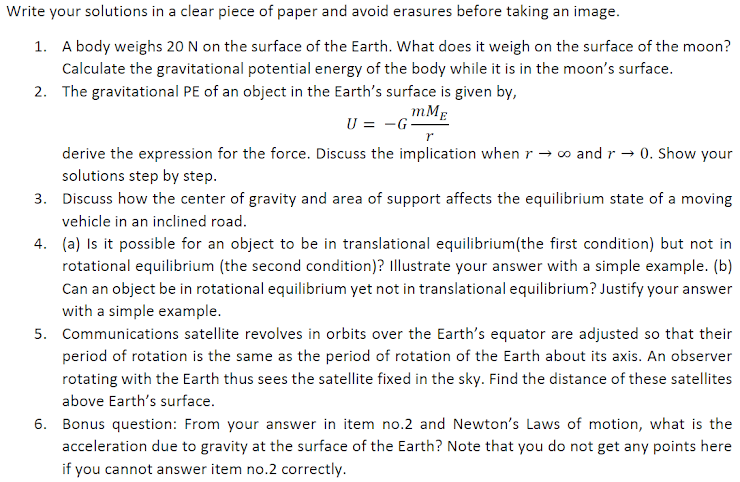1. A body weighs 20 N on the surface of the Earth. What does it weigh on the surface of the moon? Calculate the gravitational potential energy of the body while it is in the moon's surface.
1. A body weighs 20 N on the surface of the Earth. What does it weigh on the surface of the moon? Calculate the gravitational potential energy of the body while it is in the moon's surface.
College Physics
11th Edition
ISBN:9781305952300
Author:Raymond A. Serway, Chris Vuille
Publisher:Raymond A. Serway, Chris Vuille
Chapter1: Units, Trigonometry. And Vectors
Section: Chapter Questions
Problem 1CQ: Estimate the order of magnitude of the length, in meters, of each of the following; (a) a mouse, (b)...
Related questions
Question

Transcribed Image Text:Write your solutions in a clear piece of paper and avoid erasures before taking an image.
1. A body weighs 20 N on the surface of the Earth. What does it weigh on the surface of the moon?
Calculate the gravitational potential energy of the body while it is in the moon's surface.
2. The gravitational PE of an object in the Earth's surface is given by,
mMg
U = -G
derive the expression for the force. Discuss the implication when r → o and r → 0. Show your
solutions step by step.
3. Discuss how the center of gravity and area of support affects the equilibrium state of a moving
vehicle in an inclined road.
4. (a) Is it possible for an object to be in translational equilibrium(the first condition) but not in
rotational equilibrium (the second condition)? Illustrate your answer with a simple example. (b)
Can an object be in rotational equilibrium yet not in translational equilibrium? Justify your answer
with a simple example.
5. Communications satellite revolves in orbits over the Earth's equator are adjusted so that their
period of rotation is the same as the period of rotation of the Earth about its axis. An observer
rotating with the Earth thus sees the satellite fixed in the sky. Find the distance of these satellites
above Earth's surface.
6. Bonus question: From your answer in item no.2 and Newton's Laws of motion, what is the
acceleration due to gravity at the surface of the Earth? Note that you do not get any points here
if you cannot answer item no.2 correctly.
Expert Solution
This question has been solved!
Explore an expertly crafted, step-by-step solution for a thorough understanding of key concepts.
Step by step
Solved in 4 steps

Knowledge Booster
Learn more about
Need a deep-dive on the concept behind this application? Look no further. Learn more about this topic, physics and related others by exploring similar questions and additional content below.Recommended textbooks for you

College Physics
Physics
ISBN:
9781305952300
Author:
Raymond A. Serway, Chris Vuille
Publisher:
Cengage Learning

University Physics (14th Edition)
Physics
ISBN:
9780133969290
Author:
Hugh D. Young, Roger A. Freedman
Publisher:
PEARSON

Introduction To Quantum Mechanics
Physics
ISBN:
9781107189638
Author:
Griffiths, David J., Schroeter, Darrell F.
Publisher:
Cambridge University Press

College Physics
Physics
ISBN:
9781305952300
Author:
Raymond A. Serway, Chris Vuille
Publisher:
Cengage Learning

University Physics (14th Edition)
Physics
ISBN:
9780133969290
Author:
Hugh D. Young, Roger A. Freedman
Publisher:
PEARSON

Introduction To Quantum Mechanics
Physics
ISBN:
9781107189638
Author:
Griffiths, David J., Schroeter, Darrell F.
Publisher:
Cambridge University Press

Physics for Scientists and Engineers
Physics
ISBN:
9781337553278
Author:
Raymond A. Serway, John W. Jewett
Publisher:
Cengage Learning

Lecture- Tutorials for Introductory Astronomy
Physics
ISBN:
9780321820464
Author:
Edward E. Prather, Tim P. Slater, Jeff P. Adams, Gina Brissenden
Publisher:
Addison-Wesley

College Physics: A Strategic Approach (4th Editio…
Physics
ISBN:
9780134609034
Author:
Randall D. Knight (Professor Emeritus), Brian Jones, Stuart Field
Publisher:
PEARSON